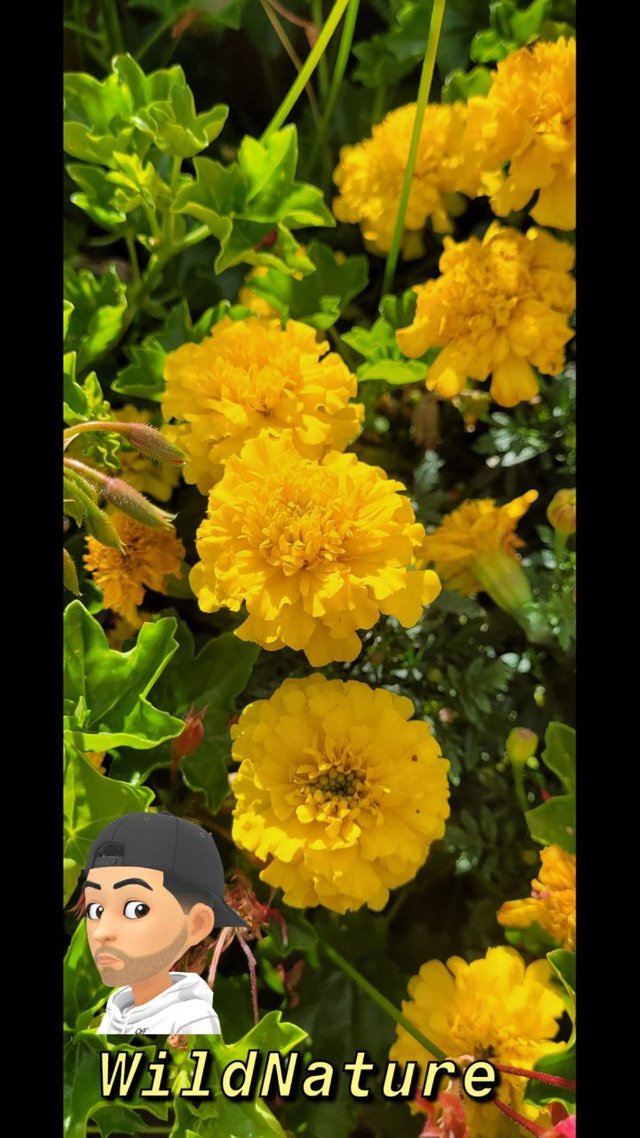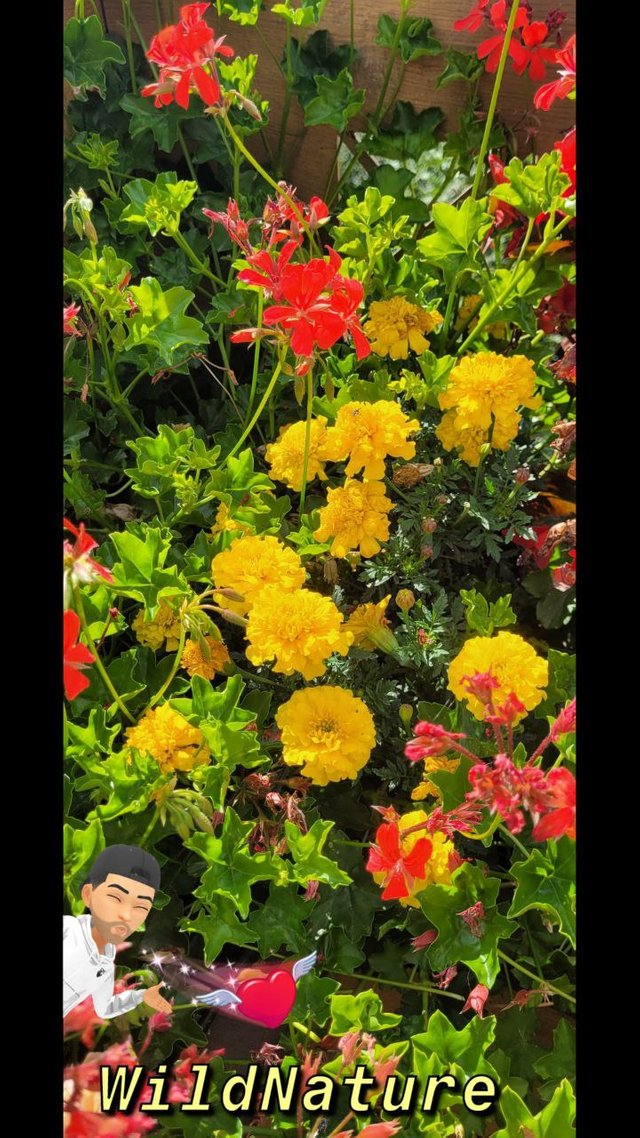Tagete 🌱🌼💛
The English version follows in the end.
Versione Italiana 🇮🇹🇮🇹🇮🇹

Il Tagete, conosciuto anche come garofano d’India, è una pianta erbacea appartenente alla famiglia delle Asteraceae, originaria delle regioni tropicali dell'America, in particolare del Messico. È molto apprezzato per i suoi fiori vivaci e la facilità di coltivazione, e viene utilizzato sia come pianta ornamentale che per le sue proprietà benefiche in giardino, dove aiuta a tenere lontani alcuni parassiti.
Il tagete è una pianta annuale o perenne a seconda della specie, con un portamento cespuglioso e compatto. Le foglie sono di un verde intenso, opposte e profondamente divise, con margini seghettati, e talvolta emettono un caratteristico odore pungente se strofinate.
La fioritura del tagete avviene durante tutta la stagione calda, da giugno fino ai primi freddi. I fiori, che possono essere singoli o doppi, hanno colori intensi che spaziano dal giallo brillante all'arancio, al rosso, spesso con combinazioni bicolore. I tageti attirano insetti impollinatori come api e farfalle, ma allo stesso tempo, grazie alla presenza di alcune sostanze repellenti, aiutano a scoraggiare nematodi e altri parassiti del suolo, rendendoli ottimi alleati per l’orto e i giardini biologici.

Dal punto di vista della coltivazione, il tagete è una pianta rustica e facile da gestire, che si adatta bene a diversi tipi di terreno, preferendo comunque quelli ben drenati e ricchi di sostanza organica. Predilige posizioni soleggiate, dove fiorisce in abbondanza, ma tollera anche l’ombra parziale. Essendo resistente al caldo e alla siccità, richiede irrigazioni moderate, evitando ristagni d’acqua che potrebbero danneggiare le radici.
Oltre al suo uso ornamentale, il tagete è conosciuto anche per alcune proprietà medicinali e cosmetiche. Viene utilizzato nella medicina tradizionale per le sue proprietà antinfiammatorie e antispasmodiche, e alcune specie sono impiegate nella preparazione di oli essenziali.
Il tagete può essere propagato facilmente per seme. La semina avviene generalmente in primavera, sia in semenzaio che direttamente in piena terra, una volta passato il rischio di gelate. I semi germinano rapidamente e le piantine crescono vigorose, garantendo una fioritura continua per tutta l'estate.
E voi, avete mai piantato tageti nel vostro giardino o nell’orto per sfruttarne le proprietà decorative e protettive? Lasciate un commento e un "like" se apprezzate questa vivace e utile pianta! 🌼🌞🌱💛
(Foto scattate da me) 📸
English version 🇬🇧🇬🇧🇬🇧

The Marigold, also known as the French marigold, is an herbaceous plant belonging to the Asteraceae family, native to the tropical regions of the Americas, particularly Mexico. It is highly appreciated for its vibrant flowers and ease of cultivation, and it is used both as an ornamental plant and for its beneficial properties in the garden, where it helps to keep certain pests away.
The marigold can be either an annual or a perennial depending on the species, with a bushy and compact growth habit. The leaves are a deep green, opposite, and deeply divided, with serrated edges, and sometimes emit a characteristic pungent odor when rubbed.
Marigolds bloom throughout the warm season, from June until the first frost. The flowers, which can be single or double, come in intense colors ranging from bright yellow to orange, to red, often with bicolor combinations. Marigolds attract pollinators like bees and butterflies, but at the same time, thanks to the presence of certain repellent substances, they help deter nematodes and other soil pests, making them excellent allies for vegetable gardens and organic gardening.

From a cultivation perspective, marigolds are hardy and easy to manage, adapting well to different types of soil, although they prefer well-drained soils rich in organic matter. They thrive in sunny positions, where they bloom abundantly, but can also tolerate partial shade. Being resistant to heat and drought, they require moderate watering, avoiding waterlogging, which could damage the roots.
In addition to their ornamental use, marigolds are also known for some medicinal and cosmetic properties. They are used in traditional medicine for their anti-inflammatory and antispasmodic properties, and some species are used in the preparation of essential oils.
Marigolds can be easily propagated by seed. Sowing generally takes place in spring, either in seedbeds or directly in the ground, once the risk of frost has passed. The seeds germinate quickly, and the seedlings grow vigorously, ensuring continuous flowering throughout the summer.
And you, have you ever planted marigolds in your garden or vegetable patch to take advantage of their decorative and protective properties? Leave a comment and a "like" if you appreciate this vibrant and useful plant! 🌼🌞🌱💛
(Photos taken by me) 📸
